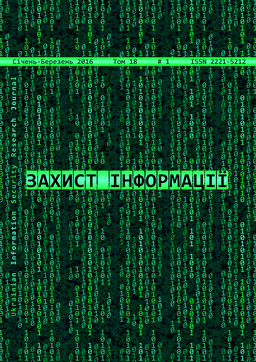Computer design of nanocircuits for cryptographic engineering
DOI:
https://doi.org/10.18372/2410-7840.18.10108Keywords:
quantum cellular automata, majority gate, D-type flip-flop, shift nanoregisterAbstract
Since the introduction of side-channel attacks, cryptographic devices have been highly susceptible to power and electromagnetic (EM) analysis attacks: because these attacks require only relatively inexpensive equipment’s. Most of cryptographic circuits are typically implemented in CMOS. There is a strong dependency between power consumption of circuits implemented based on this logic style and the data that is processed by the circuit. Due to the difference between input and output capacitances of CMOS-transistors, when the transistor switches on and off, different amount of current flows through the transistor and leads to different amount of power consumption when the transistor processes logic a “0” or logic “1”. Unless adequate countermeasures are implemented, side channel attacks allow an unauthorized person to reveal the private key of a cryptographic module. Countermeasure a novel logic approach to Quantum-dot Cellular Automata (QCA). The proposed logic takes advantage of low power consumption QCA together with complicated clocking circuits as a paradigm of nanotechnology advances in cryptography engineering.References
E. Ramini, S. M. Nejad. Secure clocked QCA logic for implementation of cryptographic processors. 2009 applies Electronics, Pilsen 9-10. September, 2009.
C. S. Lent and P. D. Tougaw, “A Device architecture for computing with quantum dots”, Proc. Of the IEEE, 1997.
Walus K. QCADesiner: A CAD Tool for an Emerging Nano-Technology / K. Walus // Micronet Annual Workshop – 2003.
Pakulov N. N. Mazhoritarnyiy printsip postroeniya nadezhnyih uzlov i ustroystv TsVM / N. N. Pakulov – M.: Sov. radio – 1974.
Downloads
Published
2016-03-23
Issue
Section
Articles
License
Authors who publish with this journal agree to the following terms:- Authors retain copyright and grant the journal right of first publication with the work simultaneously licensed under a Creative Commons Attribution License that allows others to share the work with an acknowledgement of the work's authorship and initial publication in this journal.
- Authors are able to enter into separate, additional contractual arrangements for the non-exclusive distribution of the journal's published version of the work (e.g., post it to an institutional repository or publish it in a book), with an acknowledgement of its initial publication in this journal.
- Authors are permitted and encouraged to post their work online (e.g., in institutional repositories or on their website) prior to and during the submission process, as it can lead to productive exchanges, as well as earlier and greater citation of published work (See The Effect of Open Access).

